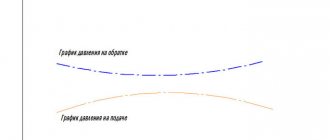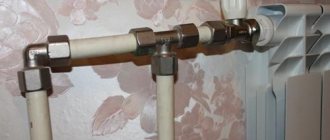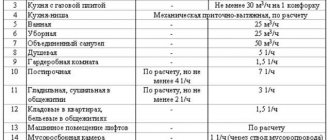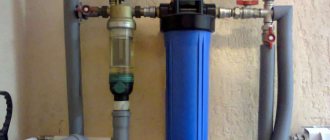- Cottage air conditioning system type
- Duct air conditioners
- Multizone air conditioners
- Inverter types of air conditioning systems
- Central air conditioning system type "chiller - fan coils - individual heating point"
- Systems with variable volume and temperature of air supplied to rooms
- Split systems and multisplit
- Installation of air conditioning systems
Send a request by email or call +7 (499) 113-68-14, and our engineer will prepare you our commercial offer.
It is best to plan air conditioning in a cottage at the construction stage, when it is possible to carry out communications. The air conditioning system will cost less, and the finish will not be damaged during installation.
The choice of air conditioners for a cottage depends on three indicators:
- type;
- power;
- brand.
Cottage air conditioning system type
The most popular types of climate control equipment are:
- wall-mounted split systems, including multi-splits;
- duct air conditioners;
- multizone systems.
Wall units are an inexpensive way to air condition a cottage.
But for a multi-room house it is not the most convenient. After all, each room will have to install its own air conditioner.
Multisplits - one outdoor module has several indoor ones. That is, you can get by with one air conditioner for a medium-sized cottage. The equipment operates quietly; the main noise comes from the outdoor unit, which is mounted outside. The air temperature in each room can be set differently. Up to 9 indoor modules are connected to one outdoor module.
Inverter?
Only the lazy have not heard of inverter air conditioners. Their motors operate on direct current, can operate at different speeds and smoothly change power.
Unlike the intermittent switching on and off at the command of the thermostat in a conventional split, the inverter can “drive” at low speeds, saving energy and maintaining the temperature at an unstable level. All these advantages are indeed present, but the degree of benefit from them is still greatly exaggerated for marketing purposes.
Duct air conditioners
Ducted air conditioning systems for cottages are widely used in America and Europe. The indoor unit is built under a false ceiling, from which ventilation ducts are distributed throughout the house.
The advantage of the systems is the ability to mix in fresh air from the street, while simultaneously providing ventilation to the premises. The system serves several rooms.
Ducted air conditioning systems for cottages have only one significant drawback: additional costs for installing ventilation ducts.
Multizone air conditioners
Optimal comfort in a large country house will be provided by multi-zone air conditioners. The biggest advantage of this method of air conditioning in cottages is the ability to lay extensive communications between the modules. Therefore, external units can be installed in any convenient location.
One outdoor unit is connected to several dozen indoor units, which can be of different types (wall-mounted, cassette). At the same time, they can simultaneously warm some rooms and cool others, which is not possible with other air conditioning systems.
Temperature changes in the rooms are only 0.5 degrees, which cannot be achieved with other types of climate control equipment.
Multizone systems simultaneously heat, air condition and ventilate rooms. At the same time, they consume less electricity than other systems of similar power.
Which air conditioner manufacturer should I choose?
Buying a budget air conditioner is always a lottery, since you can buy a low-quality unit that will quickly break down. Therefore, it is better to choose an air conditioning system from a well-known and trusted brand. The best and most expensive are the following manufacturers:
- York;
- Daikin;
- Mitsubishi Electric;
- Mitsubishi Heavy Industries;
- Fujitsu General.
There are also a number of manufacturers of a slightly lower rank. Their air conditioners are much cheaper, but they are almost as good in quality. These brands include:
- Electrolux;
- LG;
- Samsung;
- Toshiba;
- Ballu;
- General Climate and others.
Inverter types of air conditioning systems
To explain it in simple terms, inverter air conditioner models can regulate the operation of the compressor motor and create an optimal temperature regime in the room. It is the engine rotation speed that makes it possible to effectively cool or heat air masses.
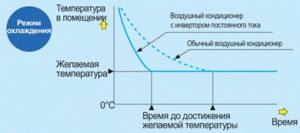
Advantages of inverter systems:
- multifunctionality;
- quick response to changes in functions;
- automatic creation of optimal temperature conditions;
- ventilation of the room with fresh air;
- ionization of air masses;
- low level of electrical energy consumption.
The functions and properties of such air conditioning models are orders of magnitude higher than standard split systems. We can say that they are also split systems, but with greater capabilities and functions. The compressors in inverter models are standard, which means that the amount of electricity consumed will be low, which will make it possible to constantly use such an air conditioning system. In the event of a breakdown, it is better to contact professionals.
It is possible to use an inverter type air conditioner in winter. Only there is a certain temperature maximum that will not allow the equipment to be operated at -10, -15 degrees below zero. The systems have adjustable blades, which makes it possible to direct air flows in the desired direction.
Advice. Inverter type air conditioners are best mounted in a corner. Thus, the flow of air masses will be in a circle.
Inverter air conditioning systems always have a beneficial effect on the indoor microclimate. Today there are different types of inverter split systems. They make it possible to connect several internal units to one external unit. As a rule, the maximum number of such connections does not exceed 5 indoor units.
Making your own air conditioner
You can start cooling the room using the simplest techniques. These methods have been known for a long time.
Damp sheet. The window is opened and curtained with this material.
Container with water. It is wrapped in a wet terry towel, and the end of the material is dipped into water. An ordinary draft can easily be replaced by a fan.
Mini air conditioners. They work on the same principle as the above systems. They are quite easy to make. And although they cannot compete with factory-made air conditioners precisely in terms of power, these home-made devices do not create unnecessary problems and are cheap.
Central air conditioning system type "chiller - fan coils - individual heating point"
Central air conditioning systems are used to heat a cottage at any outside temperature, as well as for cooling, heating and purifying the air from dust. In principle, it is possible to combine such systems with supply ventilation installations, but in practice, the air exchange of cottage premises is usually organized using supply and exhaust systems independent of the air conditioning system.
The fan coil system has a number of advantages of VRV systems, as well as very low inertia and configuration flexibility. With its help, you can condition the air in a building with any number of rooms. In air-conditioned rooms, special devices are installed - fan coils, similar to the internal units of split systems. Floor-mounted fan coils, which can be easily placed in window sill niches, are most suitable for cottages. There are also open-frame models mounted behind decorative wall panels or false ceilings.
Fan coil units with one heat exchanger are seasonal units: in the summer they are used to cool the air, and in the winter as heating devices. Fan coils with two heat exchangers are used in universal systems that can simultaneously cool, heat or simply ventilate different parts of the house. This regime is necessary primarily in spring and autumn. For ease of operation, fan coils are equipped with special remote controls and an automation system that allows group control and individual control of each fan coil in automatic or manual mode.
Fan coil units are connected to sources of cold and hot water or appropriately prepared antifreeze glycol. For domestic purposes, water or a glycol mixture is cooled by an air-cooled condenser unit chiller with a capacity of 2 to 50 kW. The most modern chillers are equipped with scroll and screw compressors and have low starting currents (which is important if the wiring of the cottage is weak), as well as high efficiency. Like the outdoor unit of VRV systems, the chiller is installed on the roof, on the wall, in the garden or in a utility room located at any distance from the house. In regions where the outside air temperature never drops below -15°C, a chiller with a heat pump mode can serve as an individual heating point. This will significantly simplify the design of the fan coil system.
In the Moscow region and in other areas of active cottage construction, where the thermometer often drops below 30°C in winter, it is best to use a gas boiler as a source of hot water or a glycol mixture, which is several times more economical than an electric chiller with a heat pump. Another source of heat is hot water from the central heating system. True, due to poor quality and high temperature, it is only suitable for indirect heating of the coolant supplied to the fan coil system.
Installation and commissioning of the “chiller - fan coil - individual heating point” system will cost the customer approximately 25-30% of the cost of the equipment, and a simplified version - 20-25%.
Check the availability of the required modes
Heating
This function is designed for the off-season, when there is no heating in the room and it’s cold outside.

In heating mode, heated freon enters the internal block of the split system, and cooled freon is output.
In many split systems, outdoor units can operate at -7 °C. At lower temperatures, the heating power decreases and there is a risk of icing of the external unit.
Some inverter models are capable of heating a room even when it is -25 °C outside the window.
Drainage
This mode makes it easier to endure sweltering heat and prevents the spread of mold. Nowadays, most air conditioners have this feature as standard.
Ventilation
This mode ensures the circulation of air in the room. As a rule, the compressor and fan of the outdoor unit of the split system are turned off, only the internal one works. Do not confuse this mode with the flow of fresh air from the street.
Air cleaning
There are coarse filters in almost every air conditioner. They block dust and larger particles like lint and fur. Filters should be removed and cleaned at least once every few months.
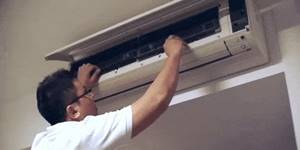
Coarse filters
Much more important is the fine filter, which is capable of capturing the smallest plant pollen, various odors and cigarette smoke. Such filters cannot always be cleaned with a vacuum cleaner or washed with water. If necessary, it is better to change filters immediately.
Consultants in stores can say a lot of flattering words about some newfangled filter, but, of course, they will not say anything about the need to replace it in a month or two.
For example, catechin filters can be used for about 30 days. After this period, they are not only useless, but also cause an unpleasant swampy smell.
Ionization
This regime refers to the saturation of the air with air ions, which should provide a surge of strength, improved immunity and well-being in general.
This mode cannot be called a marketing noodle, but many people do not feel any effect from ionization.
Aeroions are air particles that carry an electrical charge. Under natural conditions, air saturated with air ions is present on the slopes of high mountains, near waterfalls, on the banks of mountain rivers, seas and oceans.
Oxygen saturation
This mode of operation may imply completely different mechanisms.
- A special generator that uses a physical method of gas separation. It consists of two separators that absorb and remove nitrogen to the street, and return oxygen to the room.
- A special membrane that, when air is sucked in, retains nitrogen molecules but allows oxygen to pass through.
- An air exchanger for supplying fresh air from the street and removing air with a high concentration of carbon dioxide from the room.
Simple household split systems cannot supply fresh air to the room. They only “drive” the air inside the room, cooling or heating it. The refrigerant, freon, circulates through the tubes between the blocks themselves.
Systems with variable volume and temperature of air supplied to rooms
This system is capable of maintaining all the main parameters of the indoor microclimate - temperature, humidity, cleanliness and air mobility - within optimal values. This becomes possible by supplying air at a certain temperature in measured quantities to the conditioned areas. The equipment largely replicates the equipment of traditional central air conditioning systems. All air treatment, including heating, cooling, as well as centralized cleaning, humidification and ionization, is carried out by a roof-top air conditioner or a modular central air conditioner. A rooftop with indirect gas heating of the air flow is installed on the roof of a cottage or on the ground, next to the house, and is connected to the gas mains and electrical network using special equipment. A modular type central air conditioner, which is a set of various air handling devices, is located in a special technical room. The sources of heat and cold supply for it are usually an individual heating point (boiler) and a water-cooling machine - a chiller.
The prepared air is supplied to the rooms through a network of air ducts that are mounted above the suspended ceiling. The mouths of the air ducts are closed by ceiling linear diffusers or specially designed grilles that distribute air extremely evenly throughout the room.
In order to ensure that air at a strictly defined temperature enters each room, a thermostat is installed in all air-conditioned areas. In this case, several air-conditioned zones can be allocated in one large room, or a number of small rooms can be considered as one zone.
The microprocessor unit controls the operation of the air conditioner (in cooling, heating or ventilation mode) and the sequence of supply of conditioned air to the premises according to the total data of all thermostats. As a result, zone control valves installed in the ventilation ducts directly in front of the diffusers allow the required volumes of prepared air to pass through. The system includes gas analyzers, humidity sensors and other control equipment.
Installation and adjustment of a system with variable volume and temperature of air supplied to the premises at the proper level can only be performed by highly qualified specialists. The cost of these works can be up to 35% of the cost of the equipment set.
Tips for choosing
When choosing an air conditioner, consider these important points:
- Power (cooling capacity) is the main parameter that is taken into account when choosing an air conditioner;
- Compressor type – inverter or linear;
- Energy efficiency is a parameter that demonstrates the ratio of air conditioner power and electricity consumption (air conditioners with good energy efficiency are slightly more expensive, but over time they pay for themselves due to lower electricity consumption);
- Filtration system – if the house is located in a polluted area with bad air, then it is better to choose air conditioners with a good filter;
- Design – selected in such a way as not to spoil the appearance of the house;
- Automation - in most new air conditioners, many functions are automated, which greatly simplifies the operation of the device.
Split systems and multisplit
This air conditioning system is almost similar to air conditioners. There are also two blocks: internal and external. The noisy condenser and fan are mounted on the outside wall. The indoor unit contains filters and fans of the internal system. This block can be hung on any wall or ceiling.
The indoor and outdoor units are connected to each other by pipes for supplying freon, which transfers heat from the unit indoors to the outside. The radiator of the indoor unit is cooled by a fan, which prevents the unit from overheating.
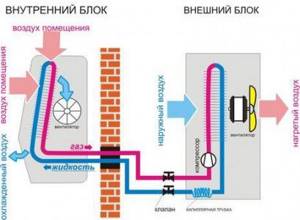
Today, split systems are equipped with a remote control. It allows you to set the following modes:
- cooling,
- heating,
- ventilation,
- drying,
- night mode.
You can use an automatic system to determine the temperature in the room and select the optimal operation of the split system. It is also possible to select the fan operation. The equipment is equipped with a timer that allows you to turn it on and off at the right time. The curtains are also adjustable, and this makes it possible to direct air masses in the desired direction.
Multisplit allows you to use several indoor units with one external unit. Each such device has its own separate remote control. Systems of this type are already equipped with special air filters. There are duct and wall-mounted multi-systems, just like air conditioners, only multi-splits have greater functionality and practicality.
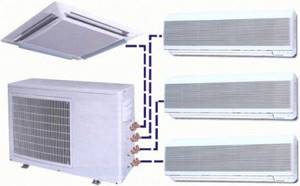
Cassette type split systems
Such systems are installed under a suspended ceiling. They can only direct air in three directions, and cooled air enters the room through the bottom of the indoor unit. Cassette split systems have greater power and distribute air masses evenly in the room.
The main advantages of such a unit include the fact that it is practically invisible and will not disrupt any design implementation. Don’t forget about saving energy, since you can use only one unit of this type in a room and it will be enough, of course, if the space itself is not too large. It is very convenient to use such an air conditioning system in the bedroom. It is practically silent and distinguished by its functionality.
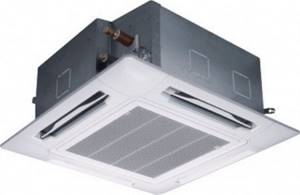
Installation of air conditioning systems
Once you have chosen the air conditioning system for your home, you need to proceed with its installation. It is best to turn to specialists for help who will not only install, but also configure the system.
Initially, it is necessary to measure the size of the system that will be located inside. If it is a split system, then the outdoor unit also needs to be measured. These actions clearly define the location for installing air conditioning systems at home.
Fasteners for mounting outdoor units must be strong. There are special enterprises that manufacture them, and I guarantee strength and durability. Fasteners are represented by metal structures of various sizes. It is possible to choose the best option.
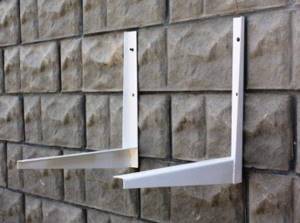
In order for the air conditioning system to work smoothly, you need to install it correctly: avoid bending the pipes through which freon is supplied. If this rule is not followed, freon may leak out and the operation of the unit will stop.
All brands of modern air conditioners and split systems are almost similar in the installation process, but each system has its own nuances. If you install the outdoor air conditioner unit on the terrace, you need to take into account that condensation from a special tube will constantly drain onto the floor. To avoid this, it is best to increase the condensate drain hose itself to the required size and move it outside the terrace or other room.

Air conditioning a private home is a very simple process. It just lies in choosing the right system based on your preferences and needs. There are a huge number of different air conditioners and split systems that differ not only in cost, but also in their functionality.
Power
When talking about air conditioners, the following designations constantly flash: “seven”, “nine”, “dvenashka”. This is the BTU parameter, a unit of heat originally from the British Isles; traditionally it denotes the amount of thermal energy that an air conditioner is capable of producing.

Since the value is not used anywhere else, the only way to interpret it is to remember the correspondence to the area for which the split system is designed:
- 7 BTU – up to 21 sq. m;
- 9 BTU – up to 26 sq. m;
- 12 BTU – up to 35 sq. m;
- 18 BTU – up to 50 sq. m;
- 24 BTU – up to 70 sq. m.
It should be noted that this interpretation is very conditional, because for a given area the height of the ceilings is unknown. Therefore, even a small hall with a second light requires a significant power split.
In addition to foreign BTUs, there is a more understandable figure - kilowatts. In this case, it is worth distinguishing between output and consumed power. The second one is more or less clear: this is how much the air conditioner takes “from the socket.” For a standard “seven”, this parameter ranges from 900 to 1300 W.
Expert opinion
Starostin Konstantin Adreevich
Air conditioner installation and maintenance specialist
The output power is the same amount of heat, but converted into kilowatts. The ratio makes it clear that the air conditioner is a fairly efficient device.


